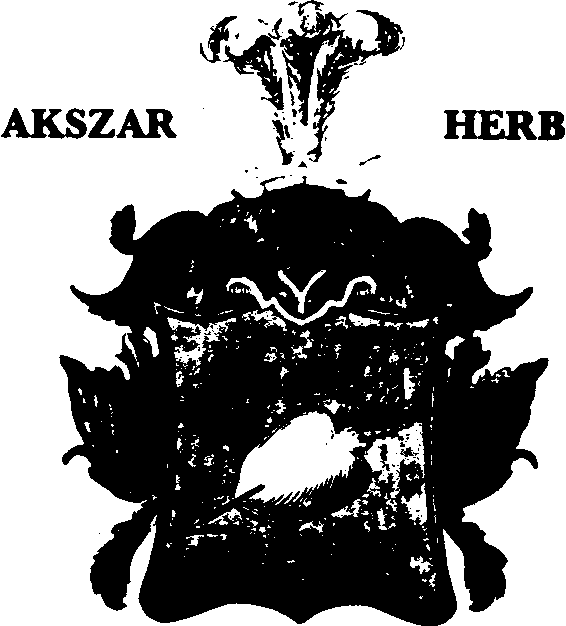Herb Akszak
Research Heraldry Herb Akszak
Herbarz Polski Translation
Akszak, Kara, Obrona herb
 The following article is a direct translation from the classic Genealogical and Heraldic reference "Herbarz Polski " by Kasper Niesiecki S.J., (Lipsk) edition 1839-46.
The following article is a direct translation from the classic Genealogical and Heraldic reference "Herbarz Polski " by Kasper Niesiecki S.J., (Lipsk) edition 1839-46.
Described by Okolski and Rutka this way: a man's heart, run through clear down the middle, turned to the side, so torn that the two parts barely hold together, in a field of red; above the helmet, three ostrich plumes. In "Petrasancta in tess. gentilit.," the writer numbers many such families of Europe, particularly in England and France, however one will not find a crest similar in composition in his work.
The origin of this crest is placed in Lithuania or Moscow, granted for bravery in routing the Tartars at the border. The champion had killed the enemy's chief who led the charging battalion. The Commander's death struck such terror in the eyes and hearts of his army that they all took flight, leaving victory in the hands13 of the opposing side. For this the crest AKSZAK was granted which according to Stryjkowski translates from Lithuanian to OBRONA (DEFENSE) which became the family name as well. However, no one mentions where the other name, KARA (PUNISHMENT), came from.
The descendants of this first AKSZAK or OBRONA migrated to Polesie where they held Tenuta Norynska for many years. Jan Akszak, at one time assistant to the voivode, transferred to Kijów where he served as land adjudicator, performed his duty to country loyally, was appointed by many Sejms (Diets) to commissions such as, in 1607, to select suitable sites in the Ukraine for fortifications. In 1611 and 1613, he helped to settle the boundary between the voivodship of Kijów and the Grand Duchy of Lithuania. In Moscow and Livonia, he gave evidence of a chivalrous heart. In the courts, he exhibited such knowledge of the Polish Law and dealt with such fairness that the sentences passed by him were never reversed, not by tribunal nor royal decree. His brother Michal gave his life for his country when he was killed smiting Tartars at Ulaniki. The sons of Jan and Barbara nee Klonska were: Marek, who spent his years in the royal camp; Stefan, land adjudicator of Kijów, subperfect of Ostrzew and Bobrowniki, who appeared as Deputy of the Radom Tribunal while a delegate to the Sejm in Warsaw in 1626. The Sejm commissioned him to settle the boundary between the Voivodship of Kijów and Czerniechów. His wife Zofja nee Mozyrska, from the chamberlain's court in Luzyce, gave birth to two sons: Jan, Master of the Pantry at Kijów, whose son Józef settled in Voivodship Belz; and, Gabryel. Stefan married anew: Katarzyna nee Czolhanska, besides three daughters, bore him two sons, Alexander and Michal, who with their brother Gabryel voted with the Kijów Voivodship to elect Jan Kazimierz. Thus did God reward Stefan with a numerous progeny for having funded the Dominican Fathers to the tune of 20,000.
Michal, the third son of Jan, Justice of Kijów, followed in the footsteps of his knightly predecessors in defending his country, and in 1632 voted to elect Wladyslaw IV. His wife was Ziemblicka.
One sister of the three brothers, after the death of her husband Grab, devoted the rest of her life to God in the convent of St. Dominik. Another sister was living with Józef Chalecki in 1650.
A Marek Akszak was in the Kijów army at Motowidlówka in 1694.
Kazimierz, treasurer of Kijów, soldiered under the Usar banner; had a son Felicyan by his wife Konstancja nee Czolhanska; lands at Ostrog.
Stefan Akszak, Master of the Pantry at Wlodzimir, Knight of the Order of St. Stanislaus, lived during the reign of King Stanislaw August. (according to Wieladek).
Akszak, general, whose wife was the widow Suffczynska nee Kuropatnicka, sister of the Castellan of Betz.
Akszak, married Wessl, sister of the royal assistant treasurer; had a son.
Akszak, colonel in the Polish Army, country squire in Radziwil; had descendants. (Krasicki).
Copyright © 1979 Josephine M. Piegzik. Used by permission. This article originally appeared in Polish Genealogical Society Newsletter (Vol. 1, No. 2, June 1979), the journal of the Polish Genealogical Society (of America).
;
